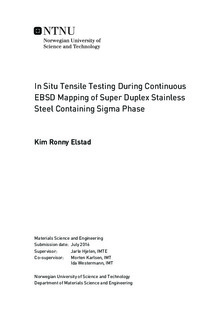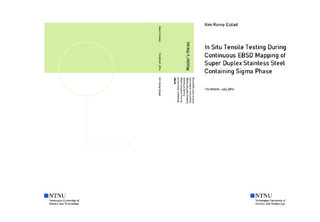| dc.description.abstract | Super duplex stainless steels (SDSS) are materials which comprise an extraordinary combination of mechanical properties, corrosion resistance and relatively low cost. SDSS were developed on the basis for use in the North Sea. However, formation of intermetallic phases e.g. sigma phase in super duplex stainless steels decrease the mechanical properties. The sigma phase grows from the ferrite/austenite-interphase and into the ferrite leaving brittle zones depleted of Cr and Mo. This makes the material prone to cracks, fracture or severe corrosion attacks.
The material was characterised both as received and heat treated material containing sigma phase. In regards to index the sigma phase before EBSD characterisation several finalising sample preparation techniques were tested. During in situ deformation continuously electron backscatter diffraction (EBSD) mapping was performed and from this the deformation was investigated. When the material is deformed there is an evolution of orientation gradients in the structure, grain rotation and crack propagation.
The examination of the orientation gradients and grain rotation was performed parallel to the tensile direction. This was done since the individual grains show a reduced rotation tendency in the normal direction while the opposite behaviour is observed in the tensile direction. There is shown that in both the austenite and the ferrite (FCC and BCC) the grain rotation is strongly dependent on the initial orientation of the grains.
In austenite the grains tend to rotate from the [101] direction and towards [112] and [111] directions. The opposite behaviour is observed in ferrite. Ferrite tends to rotate against the [101] parallel to the tensile direction. Multiple slip lines were found preferably within the austenite phase in various samples but there were also found slip lines in the ferrite. The slip lines in the ferrite were only found in the base material which did not contain any sigma phase. During this project the crack propagation after the deformation was investigated. There were only found cracks in the sigma phase and not in the ferrite or austenite. Cracking in the material follow a classical brittle behaviour and propagate perpendicular to the tensile direction. | |

